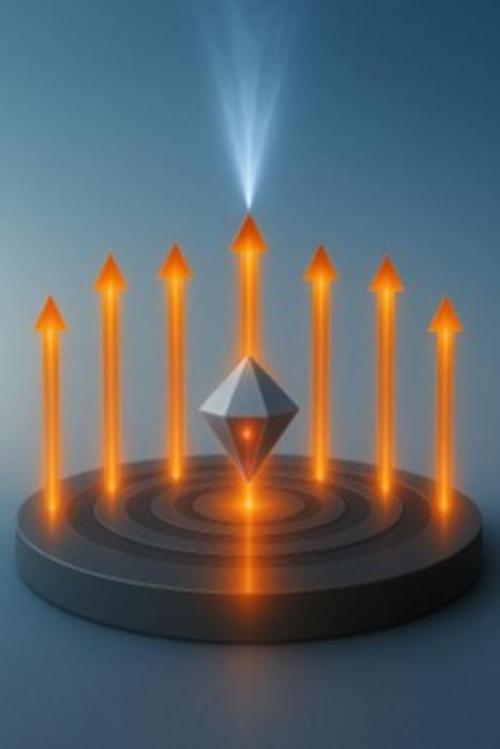Science
Researchers Develop Nanoantenna to Enhance Light Harvesting from Diamonds

A groundbreaking technique developed by researchers from the Hebrew University of Jerusalem and Humboldt Universität of Berlin promises to significantly enhance the efficiency of light harvesting from diamond defects, particularly nitrogen-vacancy (NV) centres. This advancement could have profound implications for applications in quantum technology, including quantum communication and sensing.
NV centres are formed when a nitrogen atom replaces a carbon atom in a diamond’s lattice structure, creating a vacancy. This defect behaves like a negatively charged entity with an intrinsic quantum spin. When exposed to laser light, the electron in the NV centre can be elevated to an excited state. As the electron returns to its ground state, it emits light, but capturing this emitted light has been a challenge.
Researchers, led by Boaz Lubotzky and Ronen Rapaport, highlight that NV centres emit light over a wide range of angles. Without an effective collection interface, much of this light is lost. Their innovative solution involves a hybrid nanostructure that combines a PMMA dielectric layer with a precisely designed silver grating.
Innovative Hybrid Nanostructure Enhances Light Directionality
The silver grating is arranged in a bullseye pattern, which directs light efficiently due to constructive interference. Through meticulous positioning, the researchers placed the nanodiamond containing the NV centres at the optimal location—the centre of the bullseye. Their findings reveal that using standard optics with a numerical aperture (NA) of approximately 0.5 allows the system to capture around 80% of the emitted light. As the NA increases above 0.7, this figure exceeds 90%, and may approach unity at NA values greater than 0.8.
“The device provides a chip-based, room-temperature interface that makes NV emission far more directional,” Lubotzky explains. “This means a larger fraction of photons can be captured by standard lenses or coupled into fibres and photonic chips.” The increased photon collection translates to faster measurements, higher sensitivity, and lower power consumption, transforming NV centres into compact precision sensors and enhanced single-photon sources for secure quantum communication.
Future Developments and Applications
Looking ahead, the research team aims to develop a plug-and-play module that is fully packaged and directly integrated with fibres or photonic chips. This module will employ wafer-level deterministic placement for arrays, streamlining the technology for practical use.
“We plan to leverage the enhanced light collection for NV-based magnetometry,” says Lubotzky. “This will enable faster, lower-power measurements with improved readout fidelity.” Such advancements are crucial as they will allow for quicker, more reliable operations in quantum sensors and processors.
The research findings are documented in the journal APL Quantum, contributing to the growing body of knowledge in quantum technology. The potential applications of this innovative approach are vast, from improving quantum communication systems to advancing precision measurement techniques, paving the way for future developments in the field.
-

 Entertainment2 months ago
Entertainment2 months agoAnn Ming Reflects on ITV’s ‘I Fought the Law’ Drama
-

 Entertainment3 months ago
Entertainment3 months agoKate Garraway Sells £2 Million Home Amid Financial Struggles
-

 Health2 months ago
Health2 months agoKatie Price Faces New Health Concerns After Cancer Symptoms Resurface
-

 Entertainment2 months ago
Entertainment2 months agoCoronation Street’s Carl Webster Faces Trouble with New Affairs
-

 Entertainment2 months ago
Entertainment2 months agoWhere is Tinder Swindler Simon Leviev? Latest Updates Revealed
-

 Entertainment3 months ago
Entertainment3 months agoKim Cattrall Posts Cryptic Message After HBO’s Sequel Cancellation
-

 Entertainment1 month ago
Entertainment1 month agoOlivia Attwood Opens Up About Fallout with Former Best Friend
-

 Entertainment2 months ago
Entertainment2 months agoMasterChef Faces Turmoil as Tom Kerridge Withdraws from Hosting Role
-

 Entertainment3 months ago
Entertainment3 months agoSpeculation Surrounds Home and Away as Cast Departures Mount
-

 World2 months ago
World2 months agoCole Palmer’s Mysterious Message to Kobbie Mainoo Sparks Speculation
-

 Entertainment2 months ago
Entertainment2 months agoITV’s I Fought the Law: Unraveling the True Story Behind the Drama
-

 Entertainment3 months ago
Entertainment3 months agoMarkiplier Addresses AI Controversy During Livestream Response









